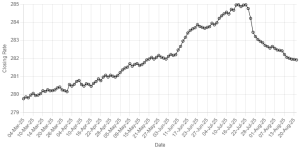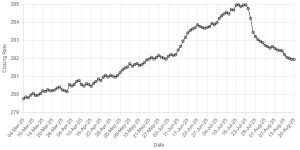The Canadian dollar's 2014 rally may be reaching its peak, according to a Reuters poll that showed analysts expect a strengthening US economy and a dovish domestic central bank to knock the currency lower before long.
Surprisingly robust Canadian inflation, signs of better global economic growth and higher oil prices combined to help push the currency to a six-month high of C$1.0627 to the US dollar, or 94.10 US cents, on Wednesday.
Momentum trading and short-covering have amplified the gains. But that strength is seen as likely to fade, with analysts calling for the loonie, as the Canadian currency is nicknamed, to decline steadily in the coming months.
The median forecast of more than 50 analysts surveyed by Reuters showed the Canadian dollar at C$1.07, or 93.46 US cents, in one month from now.
The poll showed the currency's strength eroding further as the year progresses: to C$1.09 in three months and C$1.10 in six months. In a year from now, the loonie is forecast to hit C$1.12.
"We're expecting a pullback at this point," said Greg Moore, senior currency strategist at Royal Bank of Canada, which has a 12-month target of C$1.17 for the loonie.
"In order for exports to truly pick up, and that being the key area that's expected to drive the economy in the coming years, it does mean the loonie should have to depreciate before we see some more sustainable growth."
The Bank of Canada is viewed by many analysts as preferring a weaker Canadian dollar as it looks for the export sector to become a bigger driver of economic growth. The bank has repeatedly noted its mandate is to target inflation, not the level of the currency.
After the central bank's repeated warnings about a weak inflation environment in Canada, inflation figures released last month caught markets by surprise and have put more focus than usual on the bank's next policy statement on July 16.
Annual inflation hit a 27-month high of 2.3 percent in May, coming in above the central bank's 2 percent target. The less volatile core inflation rate rose to 1.7 percent.
But rather than move away from its neutral stance, in which the bank considers interest rate cuts just as possible as rate hikes, the Bank of Canada is expected to play down the rise in inflation and focus on the still-sluggish economic growth picture. Such a viewpoint would likely pressure the loonie.
"One of the things the Bank of Canada has done really since last fall is pound the table on the issue of inflation and in particular the downside risks that are associated with it," said Mazen Issa, senior Canada macro strategist at TD Securities in Toronto.
"The market is now beginning to challenge the bank on that view and, with core inflation sitting near 2 percent, it really emphasises the communications challenge for the bank."
BR100
15,115
Increased By
28.1 (0.19%)
BR30
43,048
Increased By
175.6 (0.41%)
KSE100
149,493
Increased By
257.8 (0.17%)
KSE30
45,518
Increased By
11.6 (0.03%)























Comments
Comments are closed.